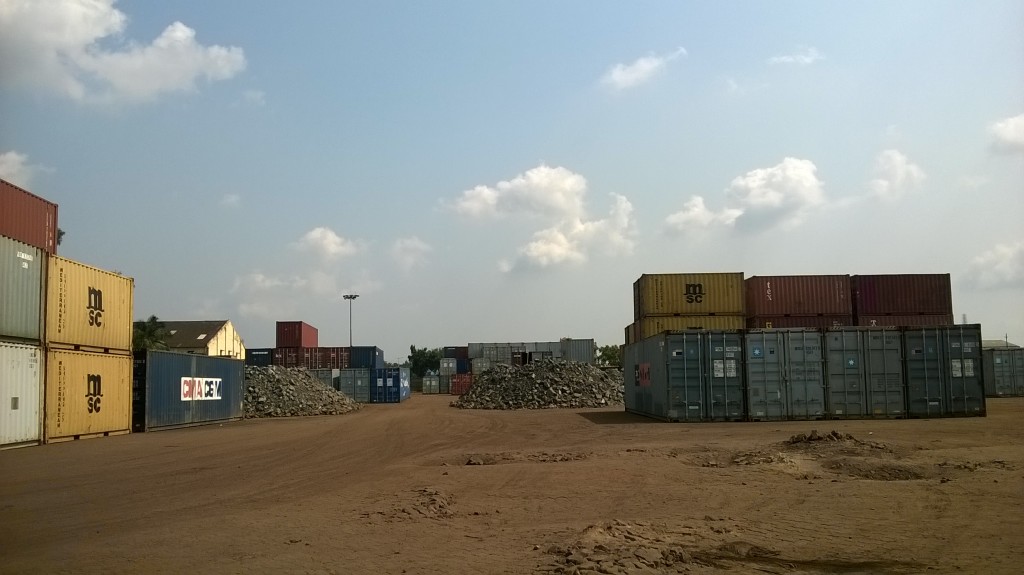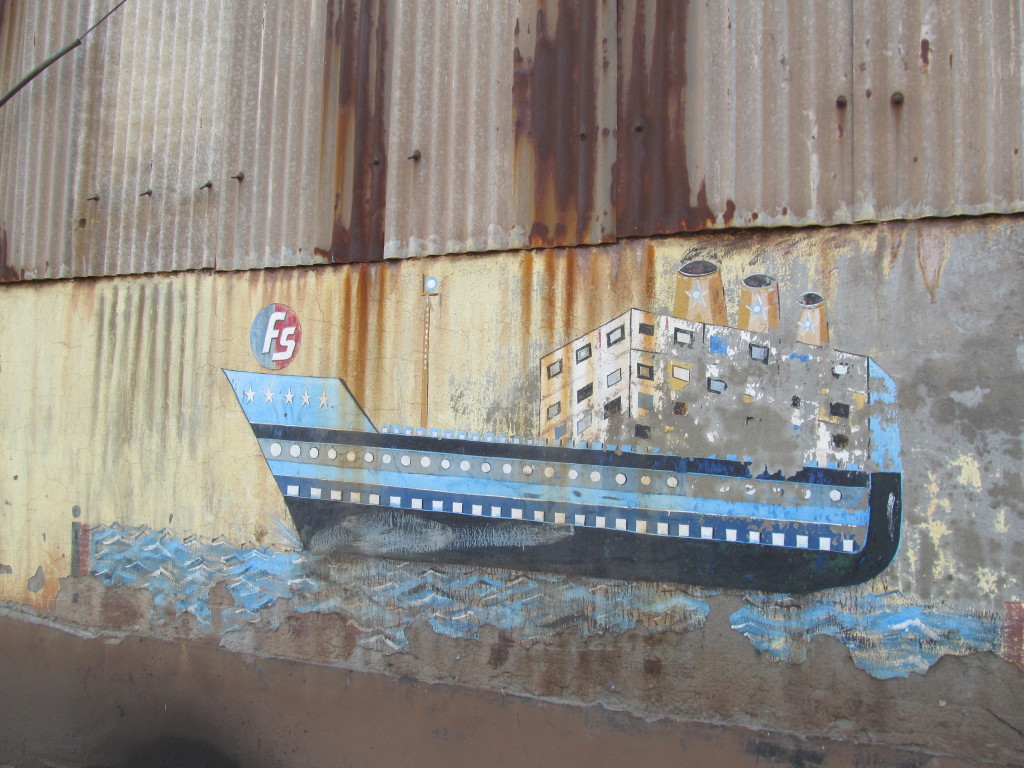Samata Biswas
Shramik Bhavan, at Ranichak, Haldia, has been considered to be at the centre of all labour mobilization and unrest in the region for many years now. Until 2011, when the state government was formed by Trinamul Congress (TMC), for the first time after a 34 year rule by the Communist Party of India (Marxist) [CPM] and its allies, Shramik Bhavan not only housed the local supremo and Member of Parliament, Lakshman Seth, it was also the headquarters for both the party and the labour union (Centre for Indian Trade Unions – CITU). There were rooms for meetings, spaces for visitors to stay, as well as an elaborate courtyard, murals on the wall and a photocopy shop. Across the road was a statue of Lenin – since 2015 it had started to crumble, and by early 2016, the metal had been removed and sold for scrap, the pedestal used to stack hay instead. After CPM’s loss at the general elections, however, the building was ransacked, window panes smashed, electricity and water cut off, making the building look far older that it actually is. A couple of red flags fluttering on the first floor balcony nevertheless attested to the CPM’s continuing association with the building, and I decided to start my research on Haldia port from this iconic, yet much abused, site.
On the first day, a darkening evening, flanked by two colleagues, I ventured through a rusted front gate, stepping on an overgrown pathway paved with broken cement tiles, into a wide corridor, dimply lit, with rooms on one side and broken windows on the other. Once inside, we ran into two people who live there, one a caretaker and the other, a secretary of some sorts, who then introduced us to some old men sitting and reading newspapers in one room. All were members of CITU units in different factories of the area. Once our project was explained to them, these men were eager to talk about the mess that the TMC had landed the state into, alternating between the glories of the CPM era and the present ruin, much like the building where they were now sitting, Somewhat emboldened, I went back alone the next day, now to meet a CITU leader of the unit at the Indian Oil Corporation and then the day after, to interview another from the Calcutta Port and Shore Mazdur union, also a CITU affiliate.
On both these occasions, the huge building seemed to be empty, and was eerily quiet, although my later foray into the refurbished parts of the building at the back revealed rooms occupied by families, signs of cooking and washed clothes hung out to dry. On the second day, I moved through secluded corridors, patches of weed and dark verandas to a freshly painted flat on the first floor, and met Sk. Mujaffar, owner of Five Star group of companies (a catch-all label for more than seven firms). Clad in bright white Kurta pyjamas, Mujjafar, entrepreneur, illiterate, father of five sons and a former aide of Lakshman Seth, proceeded to give me an outline of who’s who in Haldia, as well as a remembered history of the port, its rise and his own with it.
Sitting in a room flanked by helpers that he ordered around, Mujaffar extended unparalleled hospitality towards me, arranging for a car that would drop me home and a treat of Biryani for my roommates and I. However, at seven thirty on a Wednesday evening, somewhere at the back of Shramik Bhavan, appreciation of feudal hospitality was the last thing on my mind. I was acutely conscious of the fact that I hadn’t met or heard a woman in over three hours, and while I was given to understand that certain Trinamul families, who earlier lived in shanties, now lodged there, as well as the families of a few CPM faithful, my awareness was acute and disconcerting.
Everyone I had spoken to so far, in the course of the project, barring Tamalika Panda Seth, had been men. I had met with them at various locations, ranging from the recently refurbished Apanjon office to a Haldia Development Authority flat to Five Star warehouses to, as mentioned above, Shramik Bhavan. They have invariably occupied spaces uninterrupted by women. This, in itself, is not a surprise, as traditionally ports have been male spaces. Nelli Kambouri explains: ‘It may seem that dock work is stereotypically normalized as masculine only because in the past it required strong hands, but most of all it is the ability to work without having family or domestic care responsibilities that determine the gendered division of labour in the Port’. For people whose lives are centred, whether directly or directly, upon the port, it is no surprise that spaces are coded strictly by gender. In my analysis, I view the space of Haldia not only made and characterized by male labour, big machinery and impossible landscapes, but also as a space that constantly obfuscates the labour of women, which undoubtedly contributes to the making of this logistical space.
The port city, in existing literature, has thus far been studied as a city marked by global flows, trying to hold on to its cultural heritage in the face of neoliberal policies and containerization that threaten to disrupt the very fabric of dock-side existence, and as a city that straddles the liminal space between negative environmental impact, business growth and economic development. Managerial perspectives are of the opinion that a variety of stake holders are crucial to the dynamic and complex innovative networks that characterise port cities and their adjacent areas. Research in Haldia repeatedly brought up narratives, both official and oral, in which men have shaped this space and these networks with definite developmental goals, with the aid of science, technology and political power, or have failed to do the so, due to a lack of will, corruption, or faulty planning. Fieldwork, however, pointed at locations and spaces at the interstices of such metanarratives of progress and failure
The Haldia Dock Complex was originally just an oil jetty commissioned alongside the Haldia Urban Industrial Complex in 1959. The Haldia Dock was built in 1968 and picked up its activities with the commissioning of the Haldia Dock Complex in 1977. Ethnography highlights two different directions, one where people benefitting from the building of the dock go on to own crores of rupees, and the other, in which people are displaced with little compensation in the name of a rehabilitation package. These latter people had no land to settle on and no job. While some others had jobs but no land, and a third group found rehabilitation (only of homestead), but no jobs. Tamalika Panda Seth, the erstwhile Member of the Legislative Assembly from neighbouring Mahishadal and Chairperson of Haldia Municipality, recounts the time when the Calcutta Port Trust (CPT) wanted to acquire land. She spoke eloquently of a man called Subal Das, a technical hand at the port who was reputed to take great pleasure in pulling the roof off houses with his crane while the people living there ran out for cover, struggling to collect their belongings. It is crucial to keep in mind that this achievement of mythical proportions was aided by his mastery of new technology, the crane. The crane, with its gigantic proportions and ability to destroy, must have been an active component of children’s imaginations. Their size is coupled with the understanding that they yield great power and can only be moved and made to comply with great mastery and technique possessed by a male worker. Crane-workers comprise a sizable constituency among the Class III technicians at the Dock, the others being electricians, mechanics, welders and so forth. The crane and parts of its family, the Carl Mar, the fork lift, the loader, the pock land and the ominously named Hydra, are integral to the logistical worlds being mapped here. They lift, shift, dump, load and unload, level, lay and, as has been mentioned already, dismantle.
For some, the port made them who they are, and in his reminiscences, Mujaffar’s past is no less eloquent. He claims to have been working as a mati kata labourer when the dock was being built. Having lost all their land and home to the dock, five brothers of the family were employed by the dock itself. Since 1977 he became close to Lakshman Seth, initially being part of the Indian National Trade Union Congress (INTUC, the labour wing of Indian National Congress), which declined from 1978 onwards when people shifted to CITU. He had also become an employee of CPT in 1978, an employment that came to an end when he became a councillor of Haldia Municipality in 2002. The Five Star group of companies that Mujaffar runs is one of the biggest shipping and logistics service providers at Haldia. It undertakes loading and unloading work, as well as supplying labour, containers, trucks, cranes and warehouse space.
Anupam, an employee at Five Star, was entrusted with the job of explaining to me what logistics mean. According to him, it means handling the cargo once it comes off the ship, or from somewhere else, and preparing and loading it for its next destination. While human agency determines when, how and how many containers are shifted, the most precarious element of this logistical network remains labour. As mentioned earlier, with relation to the masculinity of the dock worker, the logistical worker is almost always male – driving trucks, supervising, manually unloading cargo from containers or trucks, shovelling materials into sacks, loading the sacks onto the trucks, guarding the godowns or operating the weigh bridge. In this logistical world, women are at best marginal, being employed to clean the warehouses, or as itinerant contractual labour employed to fix some small things, mix cement or lay bricks. In the logistical enterprise, apart from a handful of women of supervisory rank or with expert technical knowledge who are direct and permanent employees of CPT, women are at best contractually employed and their work determined by the amount and nature of cargo to be handled. Like the Dock, employment at a logistical outfit is also largely based on the ability to be flexible, a male attribute.
But in the shadow of the crumbling universe of logistics in Haldia (crumbling due to rapidly closing factories, increased influx of people from neighbouring villages, looking for job and failing to find them, reduced state spending in the Dock Complex and increased precariatization of labour), certain local (as opposed to the global flows that characterize ports), woman centric, household bound networks raise their uncertain heads. Women (deemed as belonging to the home), old men and children (both groups marginalized in terms of their participation in remunerative labour), collect iron scraps (a substantial cargo traded at Haldia Dock Complex, one meriting warehouses and container traffic) from construction debris and sell them to makeshift shops that in turn sell them to scrap wholesalers. Women also sweep and collect coal dust, sift through coal sedimentation collecting in ponds right outside the Dock Complex perimeter, dry and roll them into pellets and sell them to small shops and also use them as fuel in homes.
Big machinery, big cargo, logistical networks, warehouses, factories and oil refineries are all spaces inhabited by male labour. But in an altered scale, women and other marginal actors also form ill paid yet effective supply chains, dealing with the discarded, the excess, the spillage and creating value from them.


